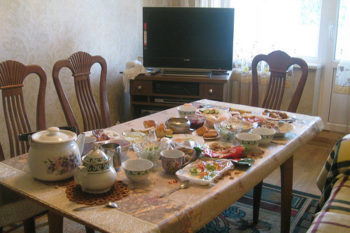“Three more day until biggest Balinese holiday” he says, mouth wide, grinning ear to ear. Scooters buzz by us in the dozens, each laden with food, flowers, forty foot long bamboo rods, or sometimes, entire families of five. As I glance to my left I see a man in his teens driving a scooter, precariously balancing a long perfectly formed bamboo rod on his shoulder, which has been cut and curved “just so” for the traditional penjor that the family compound will proudly display.
“Two more days!” she remarks, giddily. “Today, I wake up at 4:30 to begin the lawar. This morning…” she says, then pauses, raises her right hand to her neck and slides her finger across it “This morning, we cut pig”.

Penjor
And the last day before is a restless calm, scurrying with activity, with preparations, with anticipation, all for the Galungan Holiday, the biggest celebration of the year for Balinese Hindus. Galungan is a holiday that is celebrated every 210 days and lasts for ten days (this year it took place from 8th to 18th December).

Family temple offering
Galungan symbolizes the victory of good over evil (dharma over adharma). On Galungan, it is believed that deified ancestors descend back to Earth. During the Galungan ceremony, they are welcomed, entertained and honored. The last day of the holiday is Kuningan, the day on which the spirits of the ancestors descend back to heaven. Although the holiday began on a Wednesday, the island shut down the day before readying themselves. On the eve of Galungan, each house is decorated with a penjor outside the front of the house, banten are prepared, and the family temples are laden with fruit, flowers, sweets and intricate feasts of satay, lawar and other delicacies.

Village temple
On Galungan itself, the Balinese begin their prayers at the family temple, which is on the family compound, then proceed to the village temple where they join their neighbors, and conclude back in their homeland, if they have family who lives in another part of the island.
“And now you will see the Barong” he tells me, laughing softly to himself. “What is a Barong?” I ask. “You will see” he says, a subtle mix of pride and humor. “You will see many Barongs. You no miss them”.
 During the 10 days of Galungan, young boys take hold of the merry making. Groups of 4 to 20 boys, ranging from 7 to 15 years old saunter through the streets. Families congregate outside their compound in anticipation, chatting, admiring each other’s babies, all the while listening for the telltale music to approach. And he’s right… you can’t miss them. Chaotic, giddy and sweating, they are dressed in the traditional formal costume of a sarong, white shirt and headdress.
During the 10 days of Galungan, young boys take hold of the merry making. Groups of 4 to 20 boys, ranging from 7 to 15 years old saunter through the streets. Families congregate outside their compound in anticipation, chatting, admiring each other’s babies, all the while listening for the telltale music to approach. And he’s right… you can’t miss them. Chaotic, giddy and sweating, they are dressed in the traditional formal costume of a sarong, white shirt and headdress.

The centerpiece of the group is two boys, one in the head of the beast, the other in the tail, who dance along the streets dressed up as the mythical beast, or barong. Occasionally, you can see the boys peeking out the front or the back, laughing, sweating, smiling. As they pass by, the barong dancers are invited into the family home to ward off the evil spirits and restore harmony. This is an exorcism ceremony but it doesn’t feel as serious as that. Like the Balinese themselves, it feels full of renewal and hope and happiness.

Read more:
Festivals from around the world
Photo tour of West Sumatra, Indonesia
It’s Christmas in Chicago!




